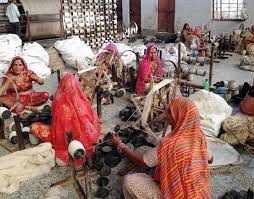Rugs from India



An Amritsar rug at the Nazmiyal collection
Carpet weaving may have been introduced into the area as far back as the eleventh century with the coming of the first Muslim conquerors, the Ghaznavids and the Ghauris, from the West. It can with more certainty be traced to the beginning of the Mughal Dynasty in the early sixteenth century, when the last successor of Timur, Babar, extended his rule from Kabul to India to found the Mughal Empire. Under the patronage of the Mughals, Indian craftsmen adopted Persian techniques and designs. Carpets woven in the Punjab made use of motifs and decorative styles found in Mughal architecture.
Akbar, a Mogul emperor, is accredited to introducing the art of carpet weaving to India during his reign. The Mughal emperors patronized Persian carpets for their royal courts and palaces. During this period, he brought Persian craftsmen from their homeland and established them in India. Initially, the carpets woven showed the classic Persian style of fine knotting. Gradually it blended with Indian art. Thus the carpets produced became typical of the Indian origin and gradually the industry began to diversify and spread all over the subcontinent. During the Mughal period, the carpets made on the Indian subcontinent became so famous that demand for them spread abroad. These carpets had distinctive designs and boasted a high density of knots. Carpets made for the Mughal emperors, including Jahangir and Shah Jahan, were of the finest quality. Under Shah Jahan’s reign, Mughal carpet weaving took on a new aesthetic and entered its classical phase.Indian carpets are well known for their designs with attention to detail and presentation of realistic attributes. The carpet industry in India flourished more in its northern part with major centres found in Kashmir, Jaipur, Agra and Bhadohi.
Indian carpets are known for their high density of knotting. Hand-knotted carpets are a speciality and widely in demand in the West. The carpet industry in India has been successful in establishing social business models that help underprivileged sections of the society. Notable examples of social entrepreneurship ventures are Jaipur rugs,Fabindia.
Another category of Indian rugs which, though quite popular in most of the western countries, have not received much press, is hand-woven rugs of Khairabad (Citapore rugs). Khairabad small town in Citapore (now spelled as “Sitapur“) district of India had been ruled by Raja Mehmoodabad. Khairabad (Mehmoodabad Estate) was part of Oudh province which had been ruled by shi’i Muslims having Persian linkages. Citapore rugs made in Khairabad and neighbouring areas are all hand-woven and distinct from tufted and knotted rugs. Flat weave is the basic weaving technique of Citapore rugs and generally cotton is the main weaving material here but jute, rayon and chenille are also popular. IKEA and Agocha have been major buyers of rugs from this area.


